The Macabre Mystery of the Missing Prince And ‘Zombie’ King
In “The Mysterious Death of Tutankhamun”, by Paul Doherty he remarks, “There is a passivity about Tutankhamun which is quite chilling.” Normally the text in the tombs of other Kings read in the present or future tenses, but as Doherty comments, “The inscriptions about Tutankhamun are always passive, in the main in the third person...”
Unique Aspects of Tutankhamun’s Tomb
There is yet more that is quite extraordinary. The important ritual of ‘the Opening of the Mouth’ was normally carried out by his successor who was never crowned until the required seventy days had passed after the late King’s tomb had been sealed. There is a scene in Tutankhamen’s tomb showing Ay carrying out the ceremony while already wearing the Crown of a King. The only reasonable answer is that the King had been dead for a long period and was sealed in an earlier tomb. There is every sign that the tomb and coffins were prepared in a great hurry, and that the latter had been moved from a larger tomb.

Ay performing the opening of the mouth ceremony. Wall painting from Tutankhamun's tomb (KV 62). (Public Domain)
The eldest Prince and heir to the throne of Egypt after YmnHtp III was TwtMs which means ‘Born of the God TWT’. As we have learned from historian Ahmed Osman ‘TWT’ was Egyptian for the Hebrew ‘DWD’, in English, DAVID.
- Everyone Knows the Mask of King Tut, but Have You Seen Any of the 5,000 Other Treasures from His Tomb?
- Enigma of the Heartless Pharaoh: Who Stole the Heart of King Tut, and Why?
His tomb has been found, but it was empty, and from all appearances, though made ready, it was never used. Nor were the final touches showing his funeral and mummification added to the walls. Had he not died so young he would have become the next King of Egypt after SalimAmen III/YmnHtpIII and so named YmnTwtAnkh, ‘The Living Gods Amen and David’. But hold on a minute, for that is the very name given to the young king found in 1922 by Howard Carter.
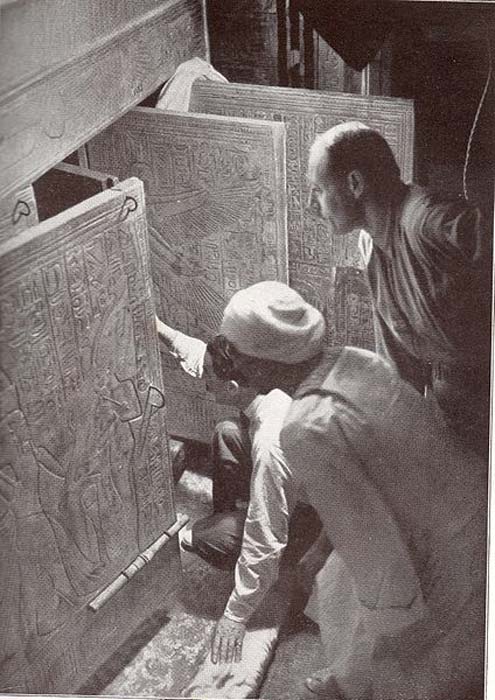
Howard Carter (kneeling), an Egyptian workman, and Arthur Callender at doors of burial shrines in Pharaoh Tutankhamen’s tomb. (Public Domain)
Examining the Familial Lineage
The Ethiopian Kebra Nagast tells us that Menyelek was also named David and that he was the eldest son of King Solomon. We know that Menyelek was YmnTwtAnkh because it is the same name. Twt or David was a Moon God and the Semite equivalent was another Moon God, EL (sometimes known as Iah, Yah or Lah). Ethiopians regarded Prince TwtMs as one of theirs for legend has it that Solomon married a girl from Abyssinia named Etiye Azeb. This has to be correct for the favorite Queen of Ymn Htp III was indeed called ‘Etiye’ and so must have been Queen Zeba or Sheba (the south-west).
Since Prince TwtMs died in his late teens or early twenties his younger brother assumed the throne alongside their father. Then after Amenhotep III died that brother changed his name from YmnHtp to Akhenaten.
When Akhenaten began to close all temples devoted to the God Ymn – Amen, and tried to change belief to a new unseen God called ‘The Aten’, the repercussions must have been enormous. Opposition drove him out of the capital city, Uaset, and so he built a new City that he named Akhetaten. We do know that something affected him intensely as proclamations found in the ruins of Akhetaten mention a great evil, greater than any others he had heard.
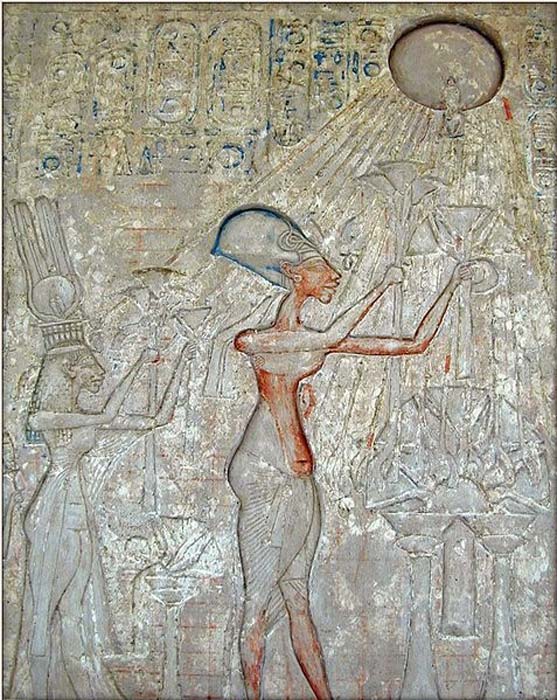
Panel with scene of Akhenaten and his family adoring the Aten (detail). (Public Domain)
Bringing the Dead Back to Life
With Akhenaten gone from Uaset, the old establishment and priests of Amen saw an opportunity to reinstate the ancient and most popular belief in Amen. Led by Ay and the General Horemheb they sought some way of ridding Egypt of a hated King who had worked thousands of his followers to their deaths. The problem was that the people believed religiously in the right of the eldest living heir to be their king. There could only be one way to replace a King of Egypt. They had to somehow show the people that the older brother had come back to life. After all, they believed that their Kings would rise again, hence the long mummification rituals.
This might well be the terrible evil that Akhenaten referred to in his proclamations. It would also explain his assertion that he was the true king.

Anubis, supervisor of the mummification process. Underneath the lion bed are the four canopic vases, for the organs that were mummified separately. (CC BY SA 2.0)
We should now look at the messages left in the Tomb of YmnTwtAnkh which leave no doubt at all to his true identity as the Missing Prince TwtMs.
Egyptologists often maintain that the tomb was filled hurriedly with personal items belonging to other people. What they fail to add is that these articles were once owned by TwtMs and that the deceased needed their own familiar possessions to take with them in the after-life.
- Unraveling Tutankhamun’s Final Secret: Cloak of Mysteries Reside in a Sepulchral Masterpiece–Part I
- Solomon and Sheba: Were a Famous Pharaoh and Queen the Real Protagonists in this Love Story?
A whip has the name of TwtMs on the handle. TwtMs had been a Priest in Memphis and the robes were his. A lock of hair from his mother Etiye was in a cofinette, thus adding to the evidence that he was not the son of Akhenaten. TwtMs did go on a campaign against Nubians and the chest in the King’s tomb depicts a scene from that battle.

The Pharaoh Tutankhamun destroying his enemies. Painting on wood. Egyptian Museum of Cairo. (Public Domain)
Deciphering the Messages Left Behind
There are also no less than four memorials which all tell us that YmnTwtAnkh was the eldest son of Amenhotep III. Yes, there have been claims that DNA proves that he was the son of Akhenaten which is quite amazing, since his mummy has never been found and identified. At the same time, we have good evidence in the Copper Scroll of Qumran that Akhenaten was the Biblical Moses.
In any case, it is the extensive analysis by Kate Phizakerley that indicates that Akhenaten could not have been the father of YmnTwtAnkh - http://www.kv64.info/2010/03/dna-shows-that-kv55-mummy-probably-not.html. Why too have the DNA results from the 18th Dynasty mummies been locked away and nobody allowed access to them? What are Egyptian Antiquities trying to hide?
The loudest message of all left in the young King’s tomb is on the back of his chair. Not only are the names of the Prince TWT MS and the King YMN ANKH TWT both there but his identity as Prince is inscribed in very large hieroglyphs as is the sign of the Ankh hanging from his arm, shouting out that he is alive.
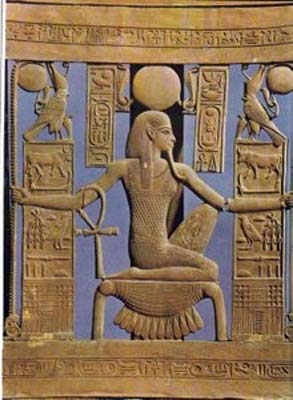
Note the sign of the Ankh hanging from his arm, shouting out that he is alive. (Author provided)
Kings’ names were written in what we now call a cartouche. Surprisingly on the chair it is much smaller than his Princely name TWT MS framed in rectangles on both side of his royal figure which are double the size of the cartouche. Whoever designed the chair was leaving no doubt that the two were one and the same and that it was important that anyone in the future seeing inside his tomb would know that this was TWTMS the eldest son of Solomon.
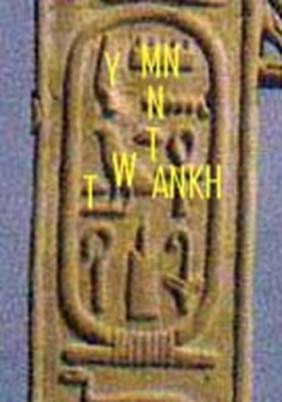
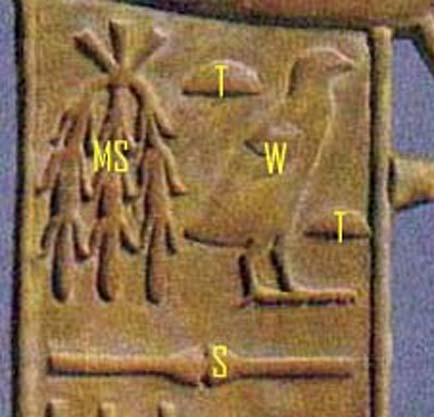
Cartouches on the chair. (Author provided)
At the far sides, left and right, he is holding a long Crook they called ‘Hek’, Hyksos in Greek, which signified rule over Sheep - a name used in the bible for the Hebrew people of Egypt who recognized the dominant constellation as being Aries. Those Egyptians who still recognized the previous constellation of Taurus as being the Manger where their Son of God was born were the cattle. That is why a number of Pharaohs are shown holding a Crook over one shoulder and a Cattle Flail over the other, showing their position as ruler of both people.
The Chair also depicts two Oxen meaning Victorious and two Arms each holding a Stick meaning powerful (or in Action and Violent). These speak more of the Prince who did fight the Nubians than the picture we have of a meek and physically feeble king.
- Tomb Hidden by History, Now Revealed: Wet Nurse of Tutankhamun May have been His Own Sister
- Dazzling Nebmaatre: Amenhotep III and the Age of Opulence—Part I

Wooden bust of the boy king, found in his tomb. (Jon Bodsworth)
Other hieroglyphs on the chair stress his being King of the Two Lands and that he was Eternal and a Giver of Life.
This chair and a Stone Ankh which also links the names of the Missing Prince with that of King Tutankhamen can only mean that they were one and the same person. The year of his accession as King was also significant for 1321 BC was a date that the King Born of the God Yah or Iah (MS IAH in Egyptian) was expected to return. This only happened once every 1,460 years when the Annual Heliacal Rising of Sirius coincided with the northern hemisphere summer solstice. The next time wouldn’t occur until 139 AD during the Age of Pisces, The Fisherman, which is why the three Wise Kings portrayed in a scene in Solomon’s Temple in Luxor were brought back into the latest version of the story that we are more familiar with.
Just how long the Priests of Amen and Ay maintained the pretense of a resurrected Prince who was now the rightful King of Egypt can only be guessed at. The damage done to his mummified remains might well have occurred when they propped the body up on some form of Sedan Chair and paraded it in public for all to view in religious processional ceremonies.
Top Image: Anubis Reconstructing Osiris (1350 BC, Tomb of Ramses 1, Egypt). Source: Asaf Braverman/CC BY NC SA 2.0


















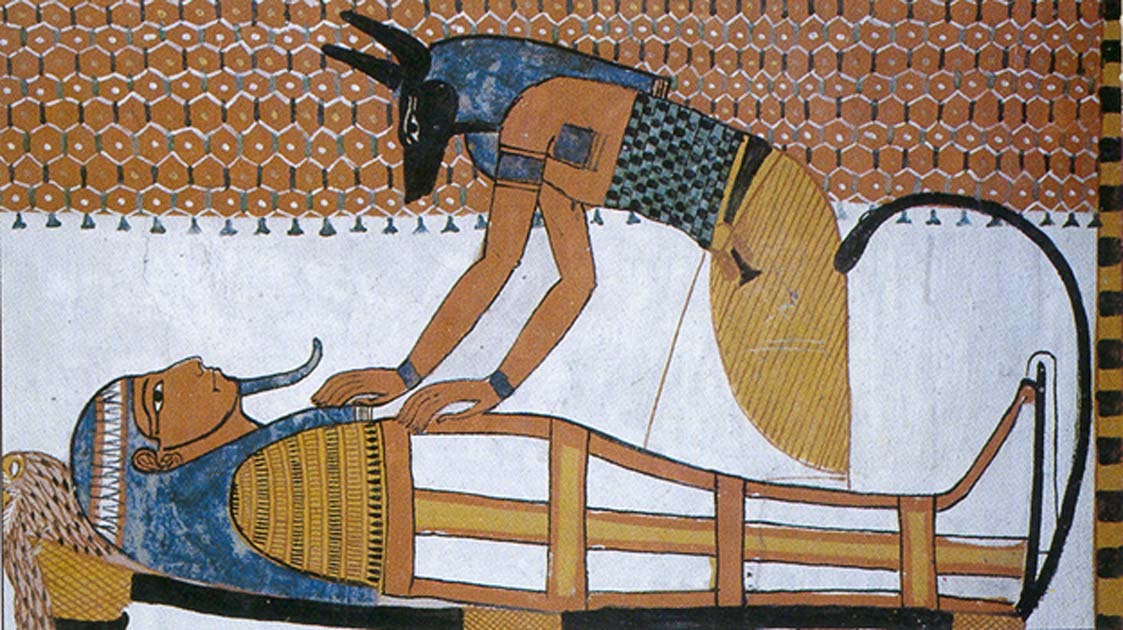

Comments
Looking forward to all of the articles.